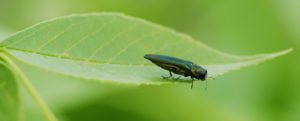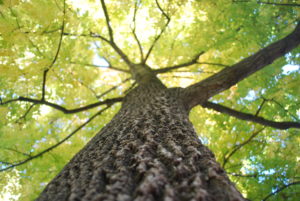This week, the invasive tree pest emerald ash borer was confirmed in the City of Longmont. This detection is still within a quarantine area established to help prevent the human-assisted spread of EAB, but represents the first confirmation of EAB anywhere in Colorado outside the City of Boulder.

On Monday, June 6, an ash tree on private land in the vicinity of 9th Avenue and Hover Street was reported by an arborist as potentially infected with the insect. He recognized the symptoms based on workshops and other information provided to him by the interagency Colorado EAB Response Team, which is working to manage the spread and impacts of the pest here in Colorado.
The insect was confirmed June 7 by experts with the Colorado Department of Agriculture and EAB Response Team as being emerald ash borer. It is unknown whether the insect arrived in Longmont by natural spread or via accidental human transport, such as in firewood or other raw ash material.
EAB was first confirmed in Colorado in September 2013, in the City of Boulder.
At this time, EAB has not been detected in Colorado outside of Boulder County or the EAB quarantine area. However, the Colorado State Forest Service and other members of the EAB Response Team continue to try to detect the pest in other locations, as an estimated 15 percent or more of all urban and community trees in Colorado are ash.

“We’ve been anticipating and preparing for EAB to be found outside of Boulder since 2013,” said Dan West, CSFS entomologist. “This new detection only re-emphasizes the need for Front Range homeowners and communities to be planning now, before EAB arrives in their neighborhood.”
Many Front Range communities, including Longmont, already have EAB management plans in place. Longmont is estimated to have an ash tree population of approximately 43,000 trees.
The EAB Response Team remains committed to outreach and detection efforts in Longmont and surrounding areas, in addition to enforcing the quarantine. The Colorado State Forest Service, partnering with Boulder County and the City of Boulder, has already set more than 120 traps targeting EAB this spring to try to detect its presence along roadways outside the City of Boulder, as well as in Longmont and other areas within Boulder County.
Top five EAB tips for Longmont and Front Range residents:
- Determine now if you have any ash trees. Identifying features of ash trees include compound leaves with 5 to 9 leaflets, leaflets, buds and branches growing directly opposite from one another, and diamond-shaped bark ridges on mature trees.
- If you have an ash tree, start planning. Decide if the overall health of the tree merits treatment or if it would be best to remove and replace it with a different species. If you aren’t sure, contact a certified arborist. If pesticide treatment is the preferred option, the applicator must be licensed by the Colorado Department of Agriculture as a Commercial Pesticide Applicator.
- Recognize signs of EAB infestation. Property owners with ash trees should be on the lookout for thinning of upper branches and twigs, loss of leaves, D-shaped 1/8-inch holes on the bark, vertical bark splitting or increased woodpecker activity. Report suspect trees by calling the Colorado Department of Agriculture at 1-888-248-5535 or by filling out an EAB report form online.
- Be aware of EAB imposters. Other insects like lilac/ash borer, ash bark beetle and flat-headed apple tree borer may look like EAB or cause similar tree symptoms.
- Help prevent further spread of EAB. Do not transport ash or any hardwood firewood, or any other untreated ash wood products, to other locations. Boulder County and some surrounding areas are under a federal EAB quarantine, allowing for stiff fines for those who move untreated wood from the area.
Learn more about ash tree identification and the symptoms of EAB and treatment options on the state Department of Agriculture’s site or via the Colorado State Forest Service.
The Colorado Master Gardener Program at CSU offers advanced training on tree issues, including the emerald ash borer. Read a SOURCE story about the Tree Teams and their mission.
The Colorado EAB Response Team includes members from the following agencies and organizations: various Front Range municipalities, Colorado Department of Agriculture, Colorado State Forest Service, Colorado State University Extension, Colorado Tree Coalition, Green Industries of Colorado, University of Colorado and USDA Animal and Plant Health Inspection Service.
The Colorado State Forest Service is a service and outreach agency of theWarner College of Natural Resources at Colorado State University.